YAMAHA SUPERJET 2014 Owner's Guide
Manufacturer: YAMAHA, Model Year: 2014, Model line: SUPERJET, Model: YAMAHA SUPERJET 2014Pages: 78, PDF Size: 2.67 MB
Page 31 of 78
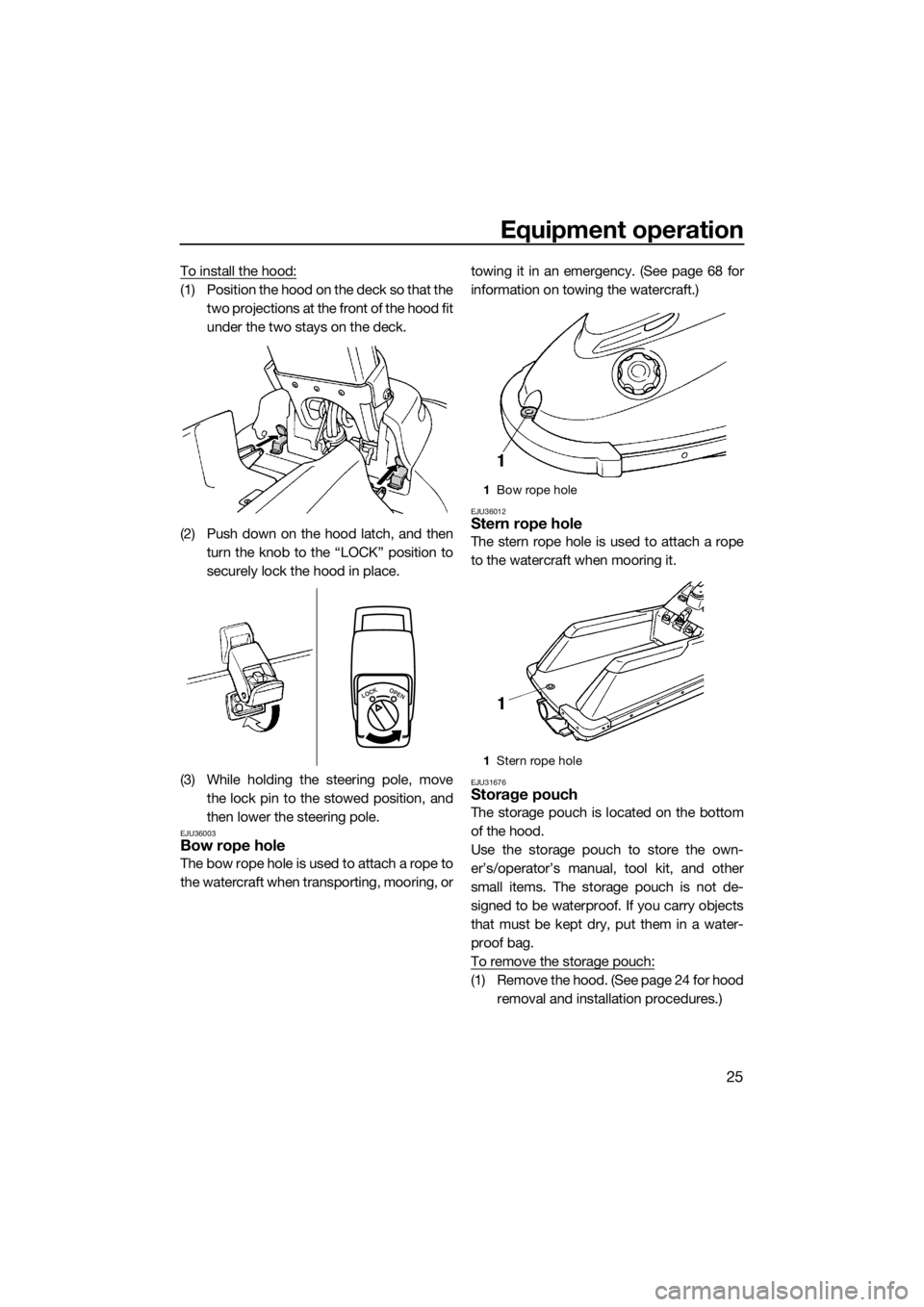
Equipment operation
25
To install the hood:
(1) Position the hood on the deck so that thetwo projections at the front of the hood fit
under the two stays on the deck.
(2) Push down on the hood latch, and then turn the knob to the “LOCK” position to
securely lock the hood in place.
(3) While holding the steering pole, move the lock pin to the stowed position, and
then lower the steering pole.
EJU36003Bow rope hole
The bow rope hole is used to attach a rope to
the watercraft when transporting, mooring, or towing it in an emergency. (See page 68 for
information on towing the watercraft.)
EJU36012Stern rope hole
The stern rope hole is used to attach a rope
to the watercraft when mooring it.
EJU31676Storage pouch
The storage pouch is located on the bottom
of the hood.
Use the storage pouch to store the own-
er’s/operator’s manual, tool kit, and other
small items. The storage pouch is not de-
signed to be waterproof. If you carry objects
that must be kept dry, put them in a water-
proof bag.
To remove the storage pouch:
(1) Remove the hood. (See page 24 for hood
removal and installation procedures.)
LOCKOPEN
1 Bow rope hole
1 Stern rope hole
UF2F76E0.book Page 25 Thursday, May 9, 2013 4:31 PM
Page 32 of 78
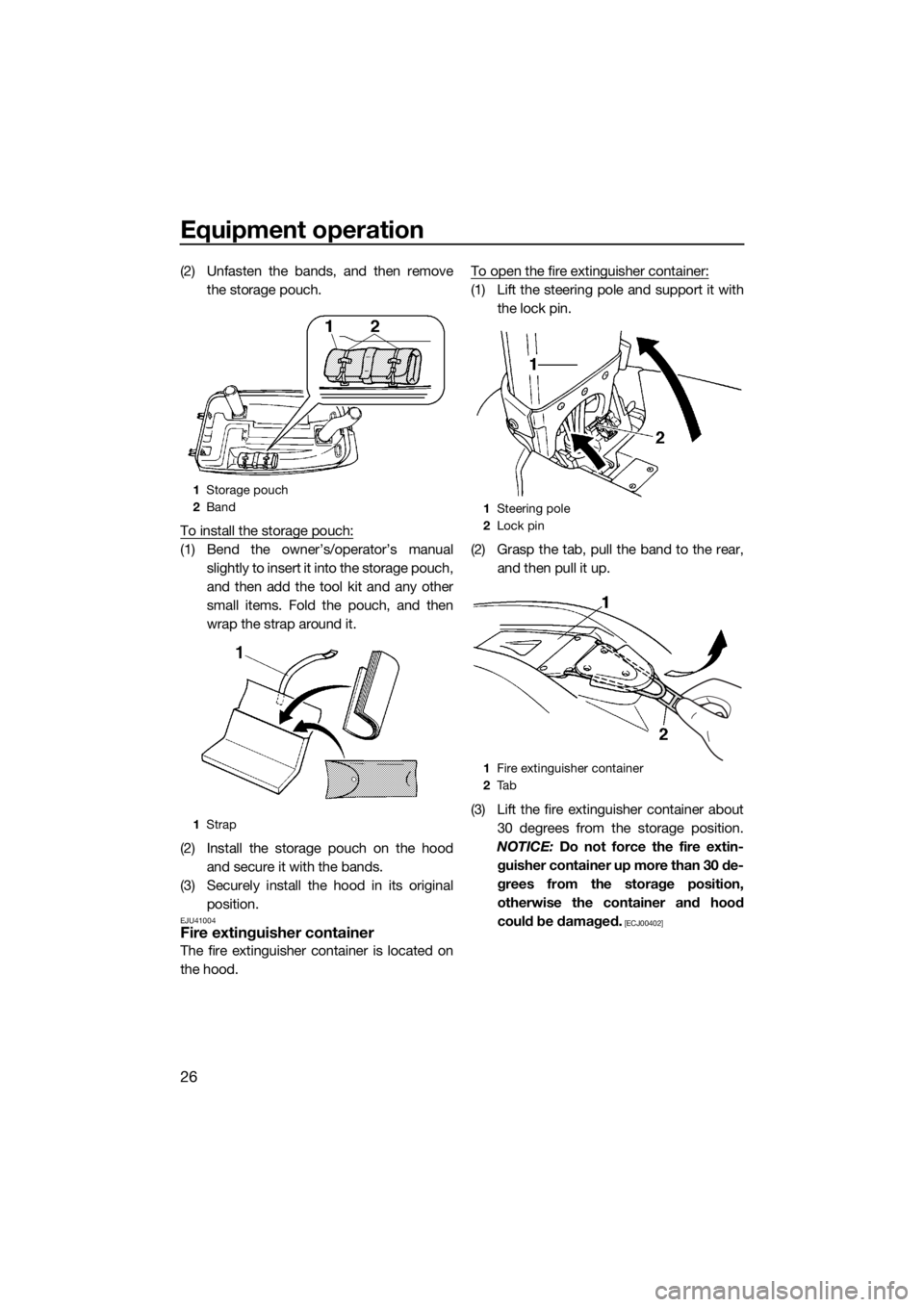
Equipment operation
26
(2) Unfasten the bands, and then remove
the storage pouch.
To install the storage pouch:
(1) Bend the owner’s/operator’s manual
slightly to insert it into the storage pouch,
and then add the tool kit and any other
small items. Fold the pouch, and then
wrap the strap around it.
(2) Install the storage pouch on the hood
and secure it with the bands.
(3) Securely install the hood in its original
position.
EJU41004Fire extinguisher container
The fire extinguisher container is located on
the hood.To open the fire extinguisher container:
(1) Lift the steering pole and support it with
the lock pin.
(2) Grasp the tab, pull the band to the rear,
and then pull it up.
(3) Lift the fire extinguisher container about
30 degrees from the storage position.
NOTICE: Do not force the fire extin-
guisher container up more than 30 de-
grees from the storage position,
otherwise the container and hood
could be damaged.
[ECJ00402]
1Storage pouch
2Band
1Strap
1Steering pole
2Lock pin
1Fire extinguisher container
2Ta b
UF2F76E0.book Page 26 Thursday, May 9, 2013 3:52 PM
Page 33 of 78
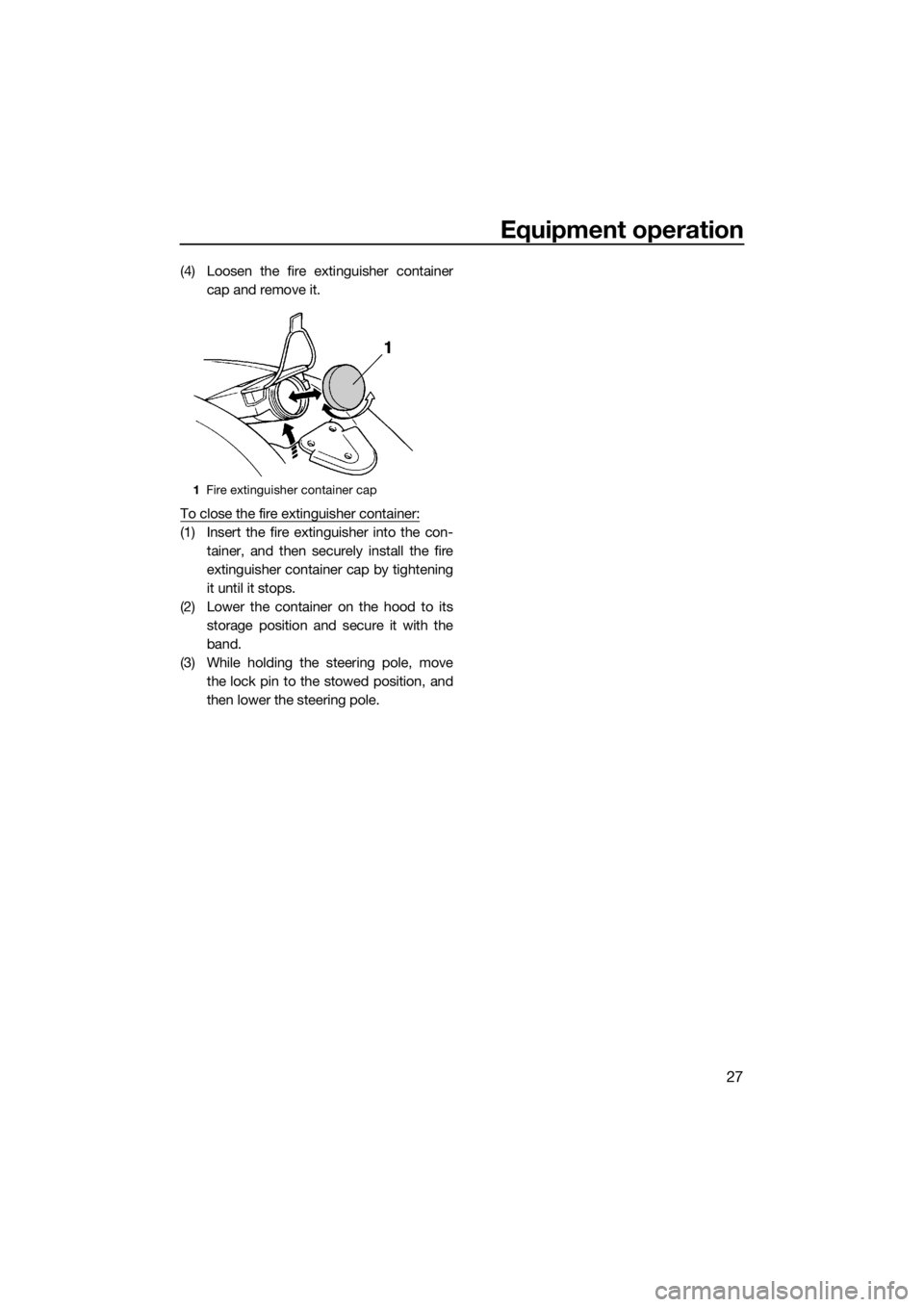
Equipment operation
27
(4) Loosen the fire extinguisher container
cap and remove it.
To close the fire extinguisher container:
(1) Insert the fire extinguisher into the con-
tainer, and then securely install the fire
extinguisher container cap by tightening
it until it stops.
(2) Lower the container on the hood to its
storage position and secure it with the
band.
(3) While holding the steering pole, move
the lock pin to the stowed position, and
then lower the steering pole.
1Fire extinguisher container cap
UF2F76E0.book Page 27 Thursday, May 9, 2013 3:52 PM
Page 34 of 78
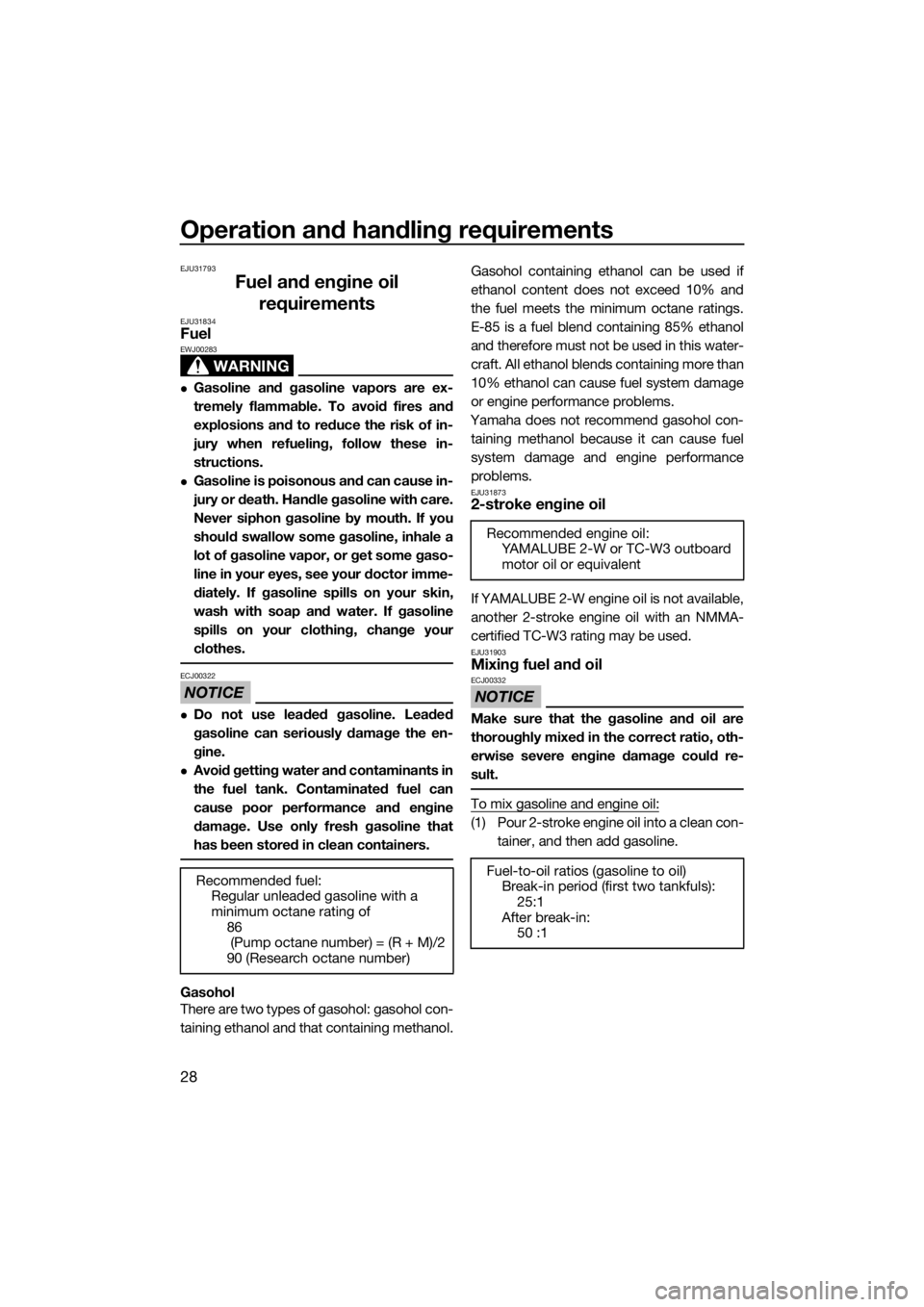
Operation and handling requirements
28
EJU31793
Fuel and engine oil
requirements
EJU31834Fuel
WARNING
EWJ00283
Gasoline and gasoline vapors are ex-
tremely flammable. To avoid fires and
explosions and to reduce the risk of in-
jury when refueling, follow these in-
structions.
Gasoline is poisonous and can cause in-
jury or death. Handle gasoline with care.
Never siphon gasoline by mouth. If you
should swallow some gasoline, inhale a
lot of gasoline vapor, or get some gaso-
line in your eyes, see your doctor imme-
diately. If gasoline spills on your skin,
wash with soap and water. If gasoline
spills on your clothing, change your
clothes.
NOTICE
ECJ00322
Do not use leaded gasoline. Leaded
gasoline can seriously damage the en-
gine.
Avoid getting water and contaminants in
the fuel tank. Contaminated fuel can
cause poor performance and engine
damage. Use only fresh gasoline that
has been stored in clean containers.
Gasohol
There are two types of gasohol: gasohol con-
taining ethanol and that containing methanol.Gasohol containing ethanol can be used if
ethanol content does not exceed 10% and
the fuel meets the minimum octane ratings.
E-85 is a fuel blend containing 85% ethanol
and therefore must not be used in this water-
craft. All ethanol blends containing more than
10% ethanol can cause fuel system damage
or engine performance problems.
Yamaha does not recommend gasohol con-
taining methanol because it can cause fuel
system damage and engine performance
problems.
EJU318732-stroke engine oil
If YAMALUBE 2-W engine oil is not available,
another 2-stroke engine oil with an NMMA-
certified TC-W3 rating may be used.
EJU31903Mixing fuel and oil
NOTICE
ECJ00332
Make sure that the gasoline and oil are
thoroughly mixed in the correct ratio, oth-
erwise severe engine damage could re-
sult.
To mix gasoline and engine oil:
(1) Pour 2-stroke engine oil into a clean con-
tainer, and then add gasoline.
Recommended fuel:
Regular unleaded gasoline with a
minimum octane rating of
86
(Pump octane number) = (R + M)/2
90 (Research octane number)
Recommended engine oil:
YAMALUBE 2-W or TC-W3 outboard
motor oil or equivalent
Fuel-to-oil ratios (gasoline to oil)
Break-in period (first two tankfuls):
25:1
After break-in:
50 :1
UF2F76E0.book Page 28 Thursday, May 9, 2013 3:52 PM
Page 35 of 78
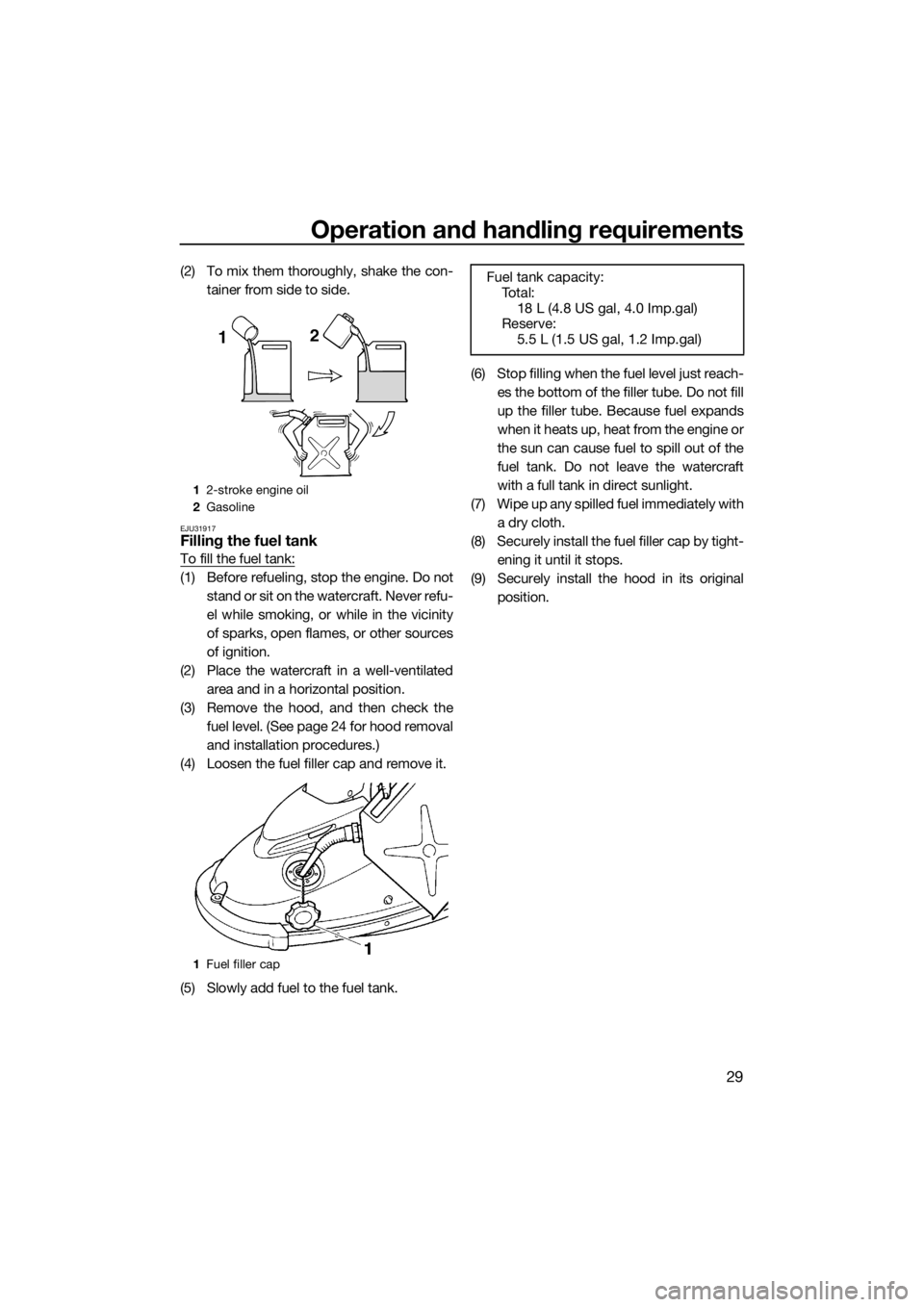
Operation and handling requirements
29
(2) To mix them thoroughly, shake the con-
tainer from side to side.
EJU31917Filling the fuel tank
To fill the fuel tank:
(1) Before refueling, stop the engine. Do not
stand or sit on the watercraft. Never refu-
el while smoking, or while in the vicinity
of sparks, open flames, or other sources
of ignition.
(2) Place the watercraft in a well-ventilated
area and in a horizontal position.
(3) Remove the hood, and then check the
fuel level. (See page 24 for hood removal
and installation procedures.)
(4) Loosen the fuel filler cap and remove it.
(5) Slowly add fuel to the fuel tank.(6) Stop filling when the fuel level just reach-
es the bottom of the filler tube. Do not fill
up the filler tube. Because fuel expands
when it heats up, heat from the engine or
the sun can cause fuel to spill out of the
fuel tank. Do not leave the watercraft
with a full tank in direct sunlight.
(7) Wipe up any spilled fuel immediately with
a dry cloth.
(8) Securely install the fuel filler cap by tight-
ening it until it stops.
(9) Securely install the hood in its original
position.
12-stroke engine oil
2Gasoline
1Fuel filler cap
Fuel tank capacity:
To t a l :
18 L (4.8 US gal, 4.0 Imp.gal)
Reserve:
5.5 L (1.5 US gal, 1.2 Imp.gal)
UF2F76E0.book Page 29 Thursday, May 9, 2013 3:52 PM
Page 36 of 78

Operation and handling requirements
30
EJU40022
Draining the bilge water
NOTICE
ECJ01302
Do not run the engine at full throttle when
bilge water remains in the engine com-
partment. The bilge water can splash into
the engine, which can result in severe
damage.
EJU40922Draining the bilge water on water
A small quantity of bilge water will remain in
the engine compartment even after the bilge
water is drained on water. To completely re-
move the bilge water, remove the watercraft
from the water and wipe up any remaining
moisture in the engine compartment with a
dry cloth.
Jet vacuum bilge draining system
While the watercraft is operating, bilge water
in the engine compartment is drawn in by the
vacuum that is generated in the jet pump and
discharged from the watercraft through the
jet thrust nozzle.
To drain the bilge water on water:
Operate the watercraft as straight as possible
and above planing speed for at least 2 min-
utes. NOTICE: Do not run the engine at full
throttle for at least 1 minute after the en-
gine has been restarted. Bilge water in the
engine compartment can splash into theengine, which can result in severe dam-
age.
[ECJ00554]
UF2F76E0.book Page 30 Thursday, May 9, 2013 3:52 PM
Page 37 of 78
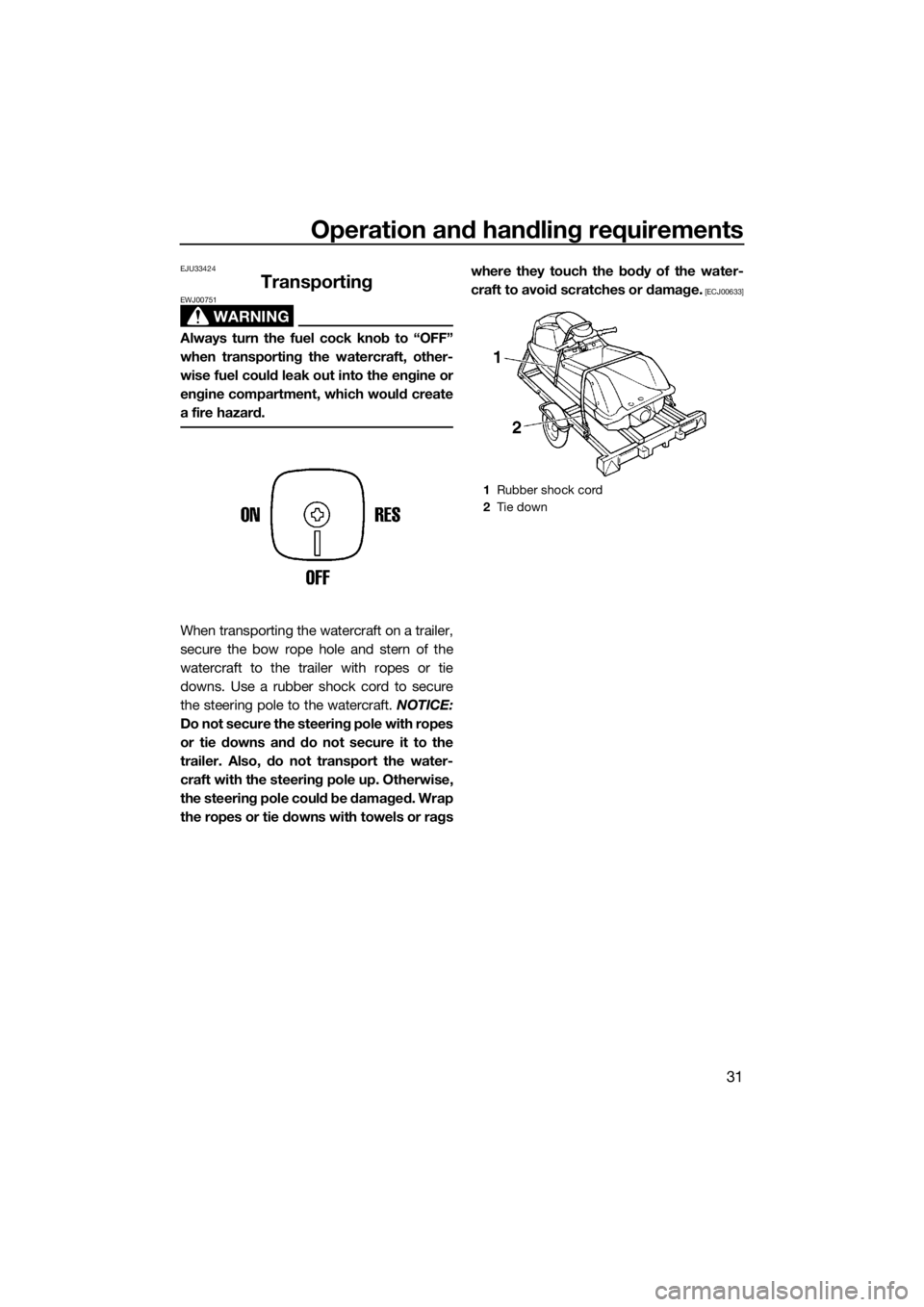
Operation and handling requirements
31
EJU33424
Transporting
WARNING
EWJ00751
Always turn the fuel cock knob to “OFF”
when transporting the watercraft, other-
wise fuel could leak out into the engine or
engine compartment, which would create
a fire hazard.
When transporting the watercraft on a trailer,
secure the bow rope hole and stern of the
watercraft to the trailer with ropes or tie
downs. Use a rubber shock cord to secure
the steering pole to the watercraft. NOTICE:
Do not secure the steering pole with ropes
or tie downs and do not secure it to the
trailer. Also, do not transport the water-
craft with the steering pole up. Otherwise,
the steering pole could be damaged. Wrap
the ropes or tie downs with towels or ragswhere they touch the body of the water-
craft to avoid scratches or damage.
[ECJ00633]
1Rubber shock cord
2Tie down
UF2F76E0.book Page 31 Thursday, May 9, 2013 3:52 PM
Page 38 of 78
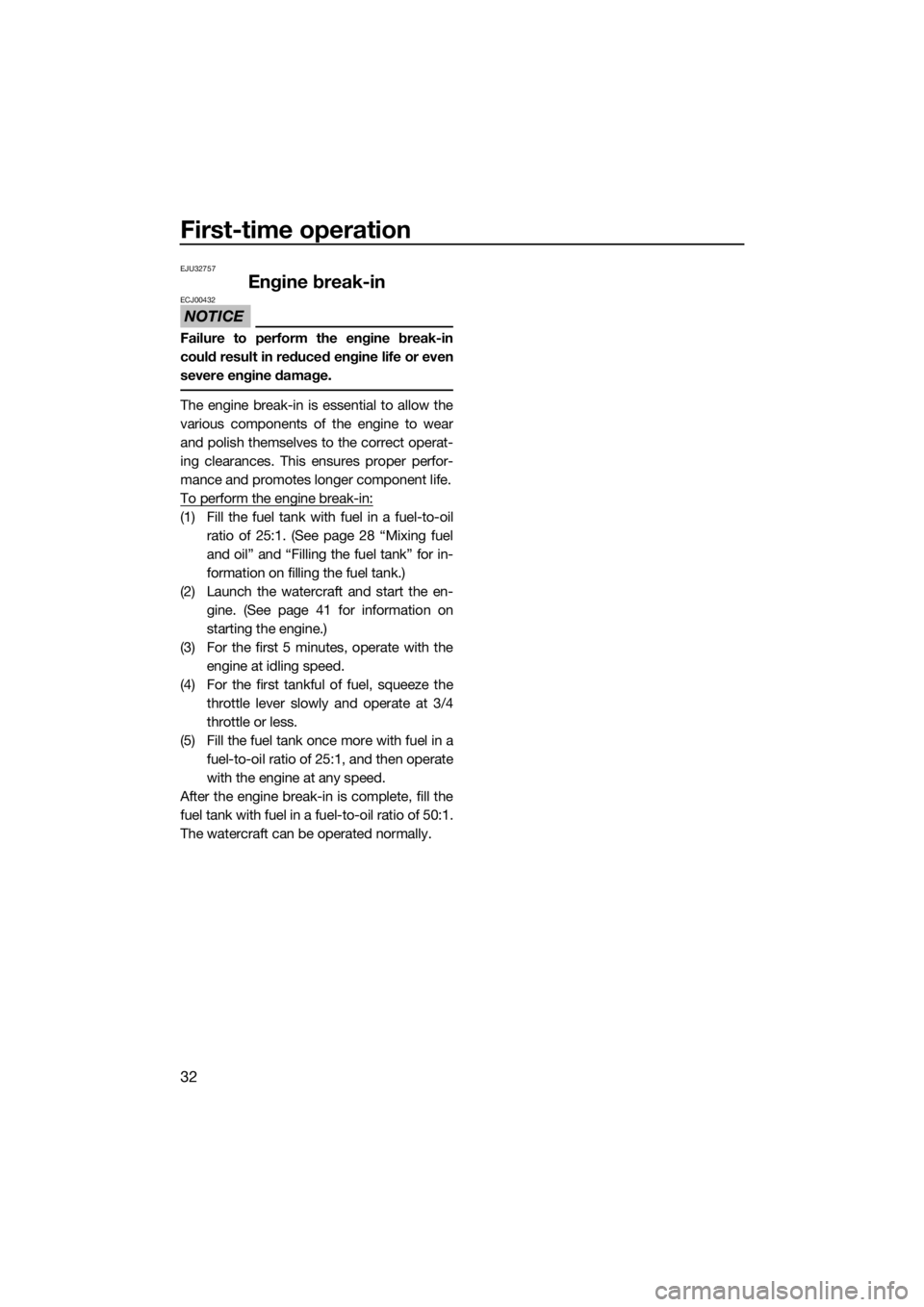
First-time operation
32
EJU32757
Engine break-in
NOTICE
ECJ00432
Failure to perform the engine break-in
could result in reduced engine life or even
severe engine damage.
The engine break-in is essential to allow the
various components of the engine to wear
and polish themselves to the correct operat-
ing clearances. This ensures proper perfor-
mance and promotes longer component life.
To perform the engine break-in:
(1) Fill the fuel tank with fuel in a fuel-to-oil
ratio of 25:1. (See page 28 “Mixing fuel
and oil” and “Filling the fuel tank” for in-
formation on filling the fuel tank.)
(2) Launch the watercraft and start the en-
gine. (See page 41 for information on
starting the engine.)
(3) For the first 5 minutes, operate with the
engine at idling speed.
(4) For the first tankful of fuel, squeeze the
throttle lever slowly and operate at 3/4
throttle or less.
(5) Fill the fuel tank once more with fuel in a
fuel-to-oil ratio of 25:1, and then operate
with the engine at any speed.
After the engine break-in is complete, fill the
fuel tank with fuel in a fuel-to-oil ratio of 50:1.
The watercraft can be operated normally.
UF2F76E0.book Page 32 Thursday, May 9, 2013 3:52 PM
Page 39 of 78
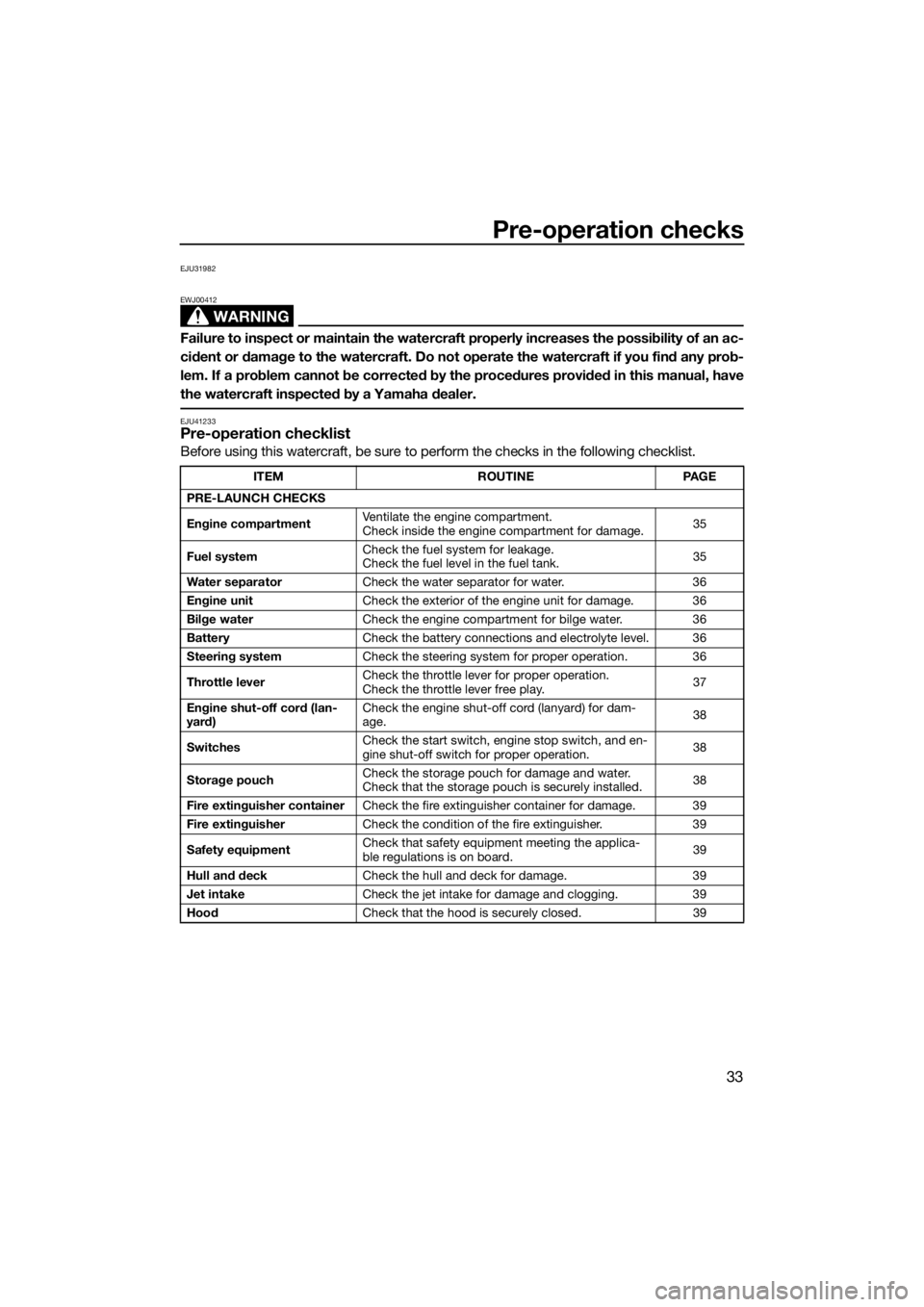
Pre-operation checks
33
EJU31982
WARNING
EWJ00412
Failure to inspect or maintain the watercraft properly increases the possibility of an ac-
cident or damage to the watercraft. Do not operate the watercraft if you find any prob-
lem. If a problem cannot be corrected by the procedures provided in this manual, have
the watercraft inspected by a Yamaha dealer.
EJU41233Pre-operation checklist
Before using this watercraft, be sure to perform the checks in the following checklist.
ITEM ROUTINE PAGE
PRE-LAUNCH CHECKS
Engine compartmentVentilate the engine compartment.
Check inside the engine compartment for damage.35
Fuel systemCheck the fuel system for leakage.
Check the fuel level in the fuel tank.35
Water separatorCheck the water separator for water. 36
Engine unitCheck the exterior of the engine unit for damage. 36
Bilge waterCheck the engine compartment for bilge water. 36
BatteryCheck the battery connections and electrolyte level. 36
Steering systemCheck the steering system for proper operation. 36
Throttle leverCheck the throttle lever for proper operation.
Check the throttle lever free play.37
Engine shut-off cord (lan-
yard)Check the engine shut-off cord (lanyard) for dam-
age.38
SwitchesCheck the start switch, engine stop switch, and en-
gine shut-off switch for proper operation.38
Storage pouchCheck the storage pouch for damage and water.
Check that the storage pouch is securely installed.38
Fire extinguisher containerCheck the fire extinguisher container for damage. 39
Fire extinguisherCheck the condition of the fire extinguisher. 39
Safety equipmentCheck that safety equipment meeting the applica-
ble regulations is on board.39
Hull and deckCheck the hull and deck for damage. 39
Jet intakeCheck the jet intake for damage and clogging. 39
HoodCheck that the hood is securely closed. 39
UF2F76E0.book Page 33 Thursday, May 9, 2013 3:52 PM
Page 40 of 78

Pre-operation checks
34
TIP:
To ensure safety and reliability, pre-operation checks should be made each time the water-
craft is used.
POST-LAUNCH CHECKS
Cooling water pilot outletCheck that water is discharged from the cooling
water pilot outlet while the engine is running.39 ITEM ROUTINE PAGE
UF2F76E0.book Page 34 Thursday, May 9, 2013 3:52 PM